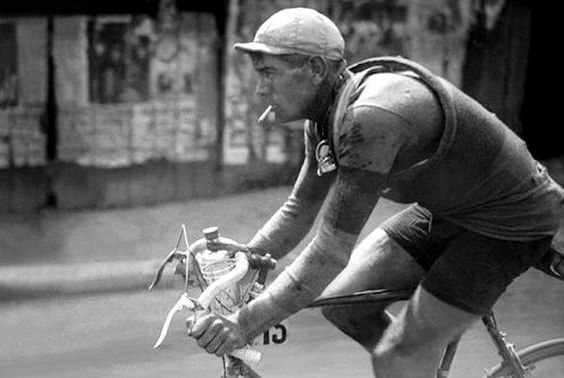The origins of the cycling outfit you wear.
During this 10-year period, cycling became a secure form of transportation for the public. At the time, the favoured bike was the penny-farthing, also known as “the ordinary”. It had a high seat and you had to start running in order to get on it. In 1885, the “safety bicycle” was created, which was so-called because its two wheels were the same size and it was lower to the ground. Three years later, inflatable tires were invented. Though bikes were popular during this decade, most people still rode in their regular clothes, which wasn’t always convenient.


As bicycles became popular, different clothing pieces were necessary for riders. Commonly, homemade wool shorts (black to obscure the fact that they were sitting on an oiled leather saddle for a long time) with either long- or short-sleeved wool jerseys, with a high neck for extra warmth, were the usual. Additionally, wool socks and leather shoes that were easy to get in and out of toe cages were worn. Wool was the fabric of choice because it kept riders warm even when wet, which is the same reason why it is still popular for socks and base layers nowadays. Modern wool does not smell bad and can be dried quickly. However, it can also be uncomfortable and sag when it comes into contact with water, leading to chafing and a lot of distress in the genital area after races.

In an effort to resolve the issue of chafing, companies started to sew a piece of leather into the pants. This fabric was initially made from the hide of the chamois. However, as these animals started to become scarce, the fabric was then made from sheepskin. To protect the skin, a type of leather conditioner named ‘chamois cream’ was applied directly to the material to make it softer and lessen harm.



Tour de France riders in the late 1920s
As Cycling racing became more popular during the 1930s and 1940s, some producers made their seats short from deer leather, which is gentler than sheepskin. Nonetheless, the leather had no impact on damping vibrations or providing a cushion for the driver – its only intent was to reduce abrasion between their skin and the rough, wet wool.

In the early 1950s, Armando Castelli and his son Maurizio, founders of the popular Italian clothing brand, presented silk jerseys to the cycling world. Silk was lighter and cooler than wool and had the capability to maintain bright colors. This enabled jersey makers to use vivid dyes to screen-print sponsor logos onto the material with more intense shades.

In the late 1950s, a new type of fabric, including nylon, polyester, polypropylene, and acrylic, was introduced to cyclists. These materials were lightweight, sweat-wicking, and easily dyed. DuPont Manufacturing created Lycra in 1959, which initially was only used by speed skiers and swimmers due to its thin and stretchy nature.

In 1976, Assos designed the first pair of Lycra cycling shorts for the Ti-Raleigh team, followed by Castelli’s black, one-size-fits-all cycling shorts in 1977. As a result of the popularity of Lycra, the use of cotton and wool shorts quickly became obsolete. The introduction of Lycra cycling shorts was highly anticipated, and customers queued up outside the factory when they were released.
Initially, cyclists donned their wool cycling shorts with suspenders to provide support and to keep them from being too tight around their midsections. In 1979, Lycra shorts acquired shoulder straps to the design.

Freddy Maertens – During the prologue of the Tour de France 1978
During the 1980s, companies such as Descente, which created a variety of outdoor products, conceived a combination of bib and suspenders made for both cycling and other sports, particularly skiing.
In 1980, Castelli innovated the first ever cushiony, non-leather chamois. Initially, it was made from cotton material, but soon after, microfibre from Japan was imported to Europe and De Marchi modified it to form foam padding. As the more affordable foam chamois became popular, companies also created chamois creams to reduce friction and discomfort on the skin, rather than just make the leather more supple.
Prior to the development of sublimation printing, cyclists’ jerseys featured much simpler designs, often with logos on just one side. These were created using colour blocking, silk screening, flocking, and embroidery. Sublimation printing, however, allowed for a much wider variety of colours and detailed designs to be transferred to the jerseys, making it possible to add company logos to the chest, back, and shoulders. This was a major advance in the sport and opened the door to sponsorship dollars. The first sublimation-printed and windproof jersey to be worn in a race was worn by Bernard Hinault at the Fleche Wallone Classic in 1983; it bore the logo of his team sponsor, Renault Elf.


Bernard Hinault at the Fleche Wallone Classic in 1983
The evolution of cycling clothing is a fascinating journey that has been shaped by advances in technology and changes in fashion. In the late 90s, cycling clothing was still primarily made from heavy wool and denim, materials that were not very breathable and could be quite uncomfortable to wear on long rides. However, as the sport of cycling began to grow in popularity, so too did the demand for more functional and comfortable clothing.


One of the major breakthroughs in the history of cycling clothing came in the early 2000s with the introduction of moisture-wicking fabrics. These synthetic materials were specifically designed to pull sweat away from the skin and keep the rider dry and comfortable. Brands like Rapha, Castelli, and Pearl Izumi began to incorporate these fabrics into their clothing lines, and soon, moisture-wicking became the standard for high-performance cycling clothing.
As the 21st century progressed, the focus on aerodynamics became increasingly important in the design of cycling clothing. Brands began to experiment with new cuts and materials that would reduce drag and help riders go faster. Form-fitting jerseys, skin suits, and even aero helmets became popular among competitive cyclists looking to gain an edge on the road.
The 2010s saw the rise of a new trend in cycling clothing, the “pro-fit” style. This style features a tighter, more form-fitting cut, designed to reduce drag and increase performance. It quickly became the norm among professional cyclists and eventually trickled down to the recreational cyclist.
Today, cycling clothing has come a long way from the heavy wool and denim of the past. Advancements in technology have allowed for the creation of lightweight, breathable, and moisture-wicking fabrics that keep riders comfortable and dry. Brands continue to experiment with new materials and designs, pushing the boundaries of what is possible in the world of cycling clothing.
And so, the history of cycling clothing has evolved from heavy wool and denim to lightweight, moisture-wicking fabrics that keep riders comfortable and aerodynamic. From the classic look of a wool jersey, to the sleek and technical designs of modern jerseys, cycling clothing has come a long way. Today’s cyclist has the benefit of choosing from a wide variety of styles and materials to suit their riding needs and personal preferences. The future of cycling clothing looks even more exciting, with new technologies being developed to improve performance and comfort even further. With each new advancement, cyclists will be able to push their limits and ride faster, farther, and in greater comfort than ever before. So grab your helmet, put on your favorite cycling clothes and hit the road!

